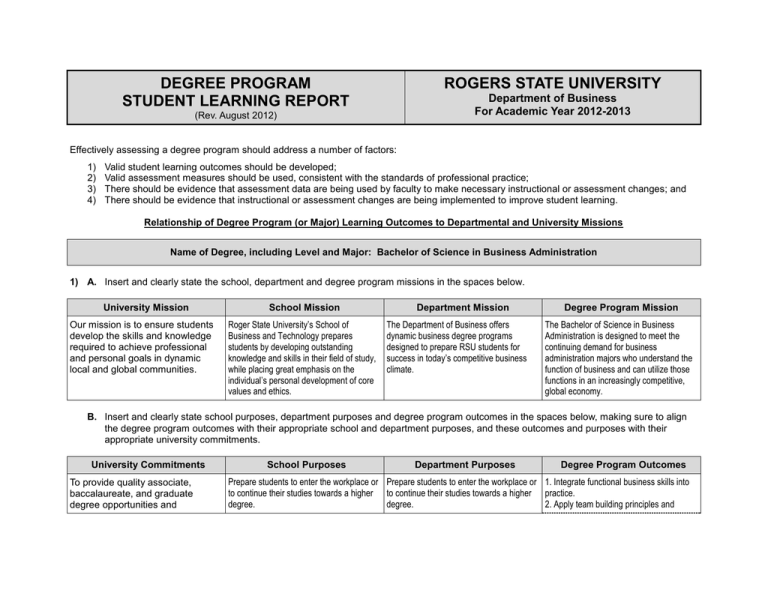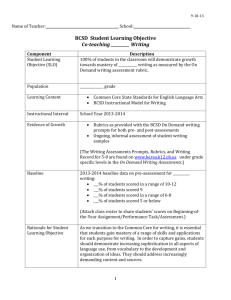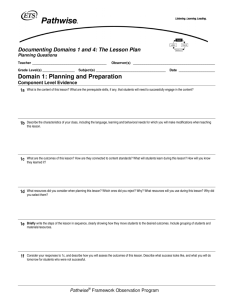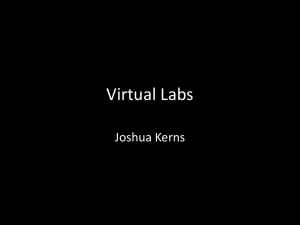degree program student learning report
advertisement

DEGREE PROGRAM STUDENT LEARNING REPORT ROGERS STATE UNIVERSITY Department of Business For Academic Year 2012-2013 (Rev. August 2012) Effectively assessing a degree program should address a number of factors: 1) 2) 3) 4) Valid student learning outcomes should be developed; Valid assessment measures should be used, consistent with the standards of professional practice; There should be evidence that assessment data are being used by faculty to make necessary instructional or assessment changes; and There should be evidence that instructional or assessment changes are being implemented to improve student learning. Relationship of Degree Program (or Major) Learning Outcomes to Departmental and University Missions Name of Degree, including Level and Major: Bachelor of Science in Business Administration 1) A. Insert and clearly state the school, department and degree program missions in the spaces below. University Mission Our mission is to ensure students develop the skills and knowledge required to achieve professional and personal goals in dynamic local and global communities. School Mission Roger State University’s School of Business and Technology prepares students by developing outstanding knowledge and skills in their field of study, while placing great emphasis on the individual’s personal development of core values and ethics. Department Mission The Department of Business offers dynamic business degree programs designed to prepare RSU students for success in today’s competitive business climate. Degree Program Mission The Bachelor of Science in Business Administration is designed to meet the continuing demand for business administration majors who understand the function of business and can utilize those functions in an increasingly competitive, global economy. B. Insert and clearly state school purposes, department purposes and degree program outcomes in the spaces below, making sure to align the degree program outcomes with their appropriate school and department purposes, and these outcomes and purposes with their appropriate university commitments. University Commitments To provide quality associate, baccalaureate, and graduate degree opportunities and School Purposes Department Purposes Degree Program Outcomes Prepare students to enter the workplace or Prepare students to enter the workplace or 1. Integrate functional business skills into to continue their studies towards a higher to continue their studies towards a higher practice. degree. degree. 2. Apply team building principles and University Commitments School Purposes Department Purposes business concepts. educational experiences which foster student excellence in oral and written communications, scientific reasoning and critical and creative thinking. To offer a learning experience which To promote an atmosphere of academic and intellectual freedom provides multiple views on global and respect for diverse expression perspectives. in an environment of physical safety that is supportive of teaching and learning. To provide a general liberal arts education that supports specialized academic program sand prepares students for lifelong learning and service in a diverse society. To provide students with a diverse, innovative faculty dedicated to excellence in teaching, scholarly pursuits and continuous improvement of programs. To provide university-wide student services, activities and resources that complement academic programs. To support and strengthen student, faculty and administrative structures that promote shared governance of the institution. To promote and encourage student, faculty, staff and community interaction in a positive academic climate that creates opportunities for cultural, intellectual and personal Degree Program Outcomes To offer a learning experience which provides multiple views on global perspectives. 3. Analyze the local, regional, national, and global business and economic environment. 4. Demonstrate tolerance of diverse views for members of the university, as well as local and communities. University Commitments School Purposes Department Purposes Degree Program Outcomes enrichment for the University and the communities it serves. Discussion of Instructional Changes Resulting from 2010-2011 Degree Program Student Learning Report 2) List and discuss all instructional or assessment changes proposed in last year’s Degree Program Student Learning Report, whether implemented or not. Any other changes or assessment activities from last year, but not mentioned in last year’s report, should be discussed here as well. Emphasis should be placed on student learning and considerations such as course improvements, the assessment process, and the budget. If no changes were planned or implemented, simply state “No changes were planned or implemented.” See Example #1 at the end of this form. Instructional or Assessment Changes - Students in the online capstone class administered the ETS Field Test in Business. - Due in part to low scores on the Finance major field area in the ETS Field test, a faculty member with a Ph.D. in Finance was hired for the 2013-2014 SY. Changes Implemented (Y/N) Impact of Changes on Degree Program Curriculum or Budget Y - No statistically significant difference existed between the online and in-class ETS scores overall or for any of the nine sections. Y -It will take approximately four semesters to determine the effect of the new faculty member due to the time between a junior level Finance class and the field test taken in the Capstone. 3) The University Assessment Committee in its Degree Program Peer Review Report provided feedback and recommendations for improvement in assessment. List or accurately summarize all feedback and recommendations from the committee, and state whether they were implemented or will be implemented at a future date. If they were not or will not be implemented, please explain why. If no changes were recommended last year, simply state “No changes were recommended.” Feedback and Recommended Changes from the University Assessment Committee - Feedback included, partially implemented. Still needs more narrative – specific conclusions related to student learning, teaching methods and approaches, course changes, etc. Suggestions Implemented (Y/N) Y Changes that Were or Will Be Implemented, or Rationale for Changes that Were Not Implemented Conclusions will have more narrative. Feedback and Recommended Changes from the University Assessment Committee Suggestions Implemented (Y/N) Changes that Were or Will Be Implemented, or Rationale for Changes that Were Not Implemented - Department agrees to include online and on-ground, designating both. Y Field test given to online students separately from on-ground students - Number listed but numbers inconsistent – same class has drastically different numbers for different measures. Y Errors in numbers corrected. - Need to draw conclusions about student learning, include narrative, discussing teaching approaches, course changes, etc. Discussed at length in peer review, department agrees to provide narrative account next year. Y Changed the format for results and conclusions. - No changes related to student learning, teaching approach. Need to address how ETS results will be improved. Many ideas discussed in peer review, just need to detail some here. Y More discussion in the conclusions for the ETS. - No best practice listed. Y Listed best practice of using SAP in the classroom. Analysis of Evidence of Degree Program Student Learning 4) For all degree program outcomes, describe the assessment measures and performance standards used, as well as the sampling methods and sample sizes. For each measure, document the results of the activity measured and draw any relevant conclusions related to student performance. Finally, indicate whether the performance standard was met or not. See Example #2 at the end of this form. A. Degree Program Outcomes 1. Integrate functional B. C. Assessmen Performance t Measures Standards Students are administered D. Sampling Methods Seventy percent All students of the students in the E. Sa mpl e Size (N) 78 F. Results Score # students # students G. Conclusions # students # students The percent above 140 was approximately the H. Perfor mance Stand ards Met (Y/N) Yes business skills into practice. 1. Integrate functional business skills into practice the Educational Testing Service Field Test in Business. The field test measures student knowledge in nine areas of business: management, marketing, accounting, economics, finance, quantitative business analysis legal and social environment, international business, and information systems. completing their major course work will demonstrate their practical applications of business knowledge by scoring at or above 140 (70 percent) on the ETS Major Field Test in Business. capstone will be administered the ETS Field Test. ETS Field Test Students will All Students 78 in Business. perform to the in capstone 50th percentile in sections. each of the nine major areas on the ETS Field Test. Over 150 140 – 149 130 – 139 Less than 130 20122013 39 20112012 28 20102011 13 20092010 15 21 22 9 7 16 13 7 6 1 1 2 0 same as 2011 - 2012. - 60 of 78 scored above 140 for 77%. Overall average 149.32. - The mean score for RSU students was 152.4 with a standard deviation of 13.8. Score # students online 23 Over 150 # students In class 16 140 – 149 13 9 130 – 139 8 8 Less than 130 1 0 36 of 45 online students scored above 140 for 80% 25 of 33 in class students scored above 140 for 75.8% Ass Ind Acct Econ Mgmt Quant Fin Legal Soc Info Sys 20122013 39 43 59 39 41 58 50 20112012 40 45 60 40 40 52 50 20102011 35 37 65 39 38 57 55 20092010 47 40 53 36 50 45 55 The online averaged slightly higher than the on-ground class, but scores are still within one standard deviation and not statistically different. When comparing 2011-2012 No and 2012-2013 scores, all areas are within 1 or 2 points either way except Legal and Social Environment which increased by 6; however it dropped by 5 the previous year. Finance and Quantitative Business Analysis continue to be a concern. Intll Issues 52 52 50 50 Mktg 57 56 54 56 Students scored below 50 % in Accounting, Economics, Quant Methods, and Finance. They scored above 50% in Management, Marketing, Legal and Social Env, Information Systems, and International Issues 1. Integrate functional business skills into practice Internships Interns will receive an average at least evaluation by five in all areas. the outside supervisor after 150 hours of work. The evaluation four areas: (Professionalis m, Attitude, Adaptability and All internship 17 are evaluated for the school year. Ass Ind 2012Ass ind 2012online 2013 inclass 2013 Acctg 39.33 37.88 Econ 43.57 41.72 Mgmt 57.12 60.75 Quant 38.20 40.78 Fin 39.69 41.53 Legal Soc 58.41 56.81 Info Sys 51.22 50.23 Intll Issues 50.80 53.19 Mktg 56.22 58.81 The online students scored slightly higher in Accounting, Economics, Legal and Social Env., and Information Systems. The on-ground scored slightly higher in Management, Quantitative Methods, Finance, International Issues, and Marketing. The averages between the online and onground in all nine major field areas were well within one standard deviation and therefore, no statistically significant difference exists. The on-ground class was higher in both finance and quantitative analysis. Professionalism Attitude Adaptability Cooperation Student interns are performing well with local businesses. - 6.2 - 6.1 - 6.0 - 6.2 Student interns scored above 5 in all areas. Previous interns performed above 5 as well. Yes Cooperation) on a Likert scale from one the lowest to seven the highest. 1. Integrate functional business skills into practice. Pretest and posttest scores will be evaluated in BADM 3113 Business Communication s a. Students will improve posttest scores over pretest scores by at least 20%. b. Students will score at least 70% on posttest Complete 106 Pretest avg – 46% sections Posttest avg – 72% were chosen as samples Students increased the BADM 3113 posttest and over pretest by 63.8%. administered the pretest and the same group administered the posttest. 2. Apply team building principles and business concepts. Students will form in teams in the capstone course and participate in the external Business strategy Game Simulation (BSG) by McGraw-Hill. Seventy percent of the teams will score at least 70% on the BSG Capstone students were not formed in teams. 4. Demonstrate tolerance of diverse views for members of the university, as well as local A student survey was conducted to show satisfaction with the 100% of students will answer yes to the program stressing tolerance to Four 78 sections of the capstone were surveyed. 0 Pretest/posttest show Yes no indications of course deficiencies. Teams not formed for BSG. Individuals scored. Will form teams next semester. 78 (100%) students responded yes to the diversity question. No . Yes and communities. program. diverse Two groups. questions were: 1) Do you feel the program was beneficial and 2) Did the program stress tolerance for diverse groups? 5) State any proposed instructional or assessment changes to be implemented for the next academic year. They should be based on conclusions reported in Section 4 (above) or on informal activities, such as faculty meetings and discussions, conferences, pilot projects, textbook adoption, new course proposals, curriculum modifications, etc. Explain the rationale for these changes and how they will impact student learning and other considerations, such as curriculum, degree plan, assessment process, or budget. If no changes are planned, simply state “No changes are planned.” [See EXAMPLE #1 at the end of this form.] Degree Program Outcomes Adding EXCEL in the classroom for Finance and selected upper level Accounting courses. Instructional or Assessment Changes Instructors in the upper level Finance and selected Accounting classes will utilize EXCEL in classroom instruction and student assignments. Rationale for Changes Impact of Planned Changes on Student Learning and Other Considerations. Although not emphasized in most Student learning will consist not only of texts, EXCEL is used extensively financial and accounting concepts, but in industry. Graduates familiar with advanced EXCEL operations as well. EXCEL have an advantage in the workplace at financial institutions. 6) In order to benefit the broader university community, please describe one or more practices the department believes has potential for pedagogical benefit. This is similar to what is known as a “best practice,” which is a strategy, method or technology that in the professor’s or department’s experience improves classroom instruction and student learning. There should be preliminary reason to believe the practice can be replicated and generalized to other faculty and educational settings. Please include a department contact person, a brief description, and its potential or demonstrated educational impact. If there are none to report, put “none” in the Best Practice column. Best Practice Using SAP in the classroom. Contact Person Dr. Bert Tollison Description Educational Impact Enterprise Resource Planning (ERP) is a very powerful software tool being used in industry. SAP is ERP program that has been adopted by over 80 percent of the Fortune 1000 companies. RSU is a member of the SAP academic consortium where instructors and students receive direct server support, faculty raining, and exercises for the classroom. The Business Department presently provides three courses with at least 30% of the class conducted using SAP. Two of the classes are required in the program core and one is offered as an elective. Any student who takes at least three classes with 30% using SAP receives and certificate from SAP. This certificate gives the graduate of the Business Program a competitive advantage in the workforce. 7) Assessment Measures: A. Six B. List the direct measures (see rubric ETS Field Test, Business Communications Pre-test, Post-test, BSG Simulation. C. List the indirect measures (see rubric): Satisfaction Survey.



